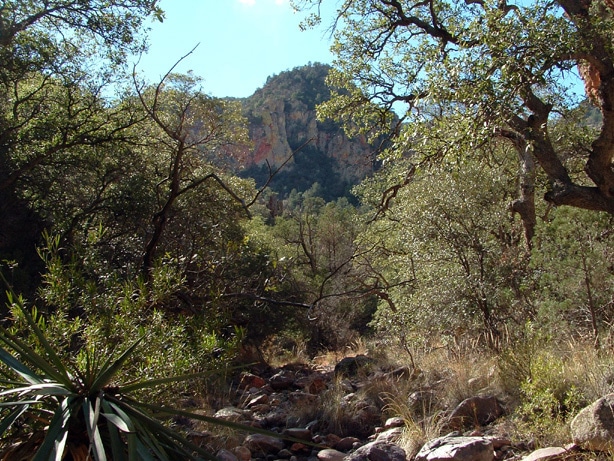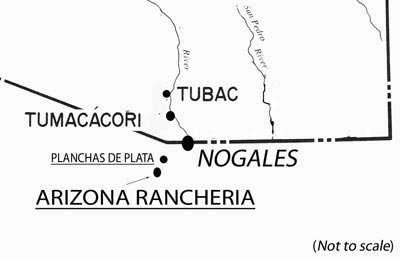This article was translated by John R. Bopp
We commented on this back in the “prehistory” of our blog. Back in March of 2011, we told how the name of the 48th state of the US might be Basque, based on the word aritz, or “oak”.
Now, we’ve come across another article penned by Al Bates in the Prescott, Arizona Daily Courier, giving more information on the origin of the name and how it became the name of the state. But also, and this is especially interesting, he references the website of Tumacacori National Park, where, in addition to summarizing the name’s origin, we can also find two studies done by Donald T. Garate, which abound in this line in defense of the Basque origin for this state’s name.


We found a story about the discovery of silver in 1767, which was a bit strange, since inside the silver, there was a slab-shaped piece that weighed, by itself, at least 2,500lb or 1,100kg. The discovery was made in the area close to a ranch that belonged to a Basque named Bernardo de Urrea, who was the lieutenant mayor to Juan Bautista de Anza, the highest Justice in Sonora, Viceroyalty of New Spain. The rance was called Arizona, since in that area there are tons of oaks of good quality. This name began to gain currency thanks to its appearance in the documents referring to the silver discovery.
“Toward the end of last October, between the Guevavi Mission and the ranchería called Arizona, some balls and slabs of silver were discovered, one of which weighed more than one hundred arrobas (2,500 pounds), a sample of which I am sending to you, Most Illustrious Lord.” Captain Juan Bautista de Anza to Bishop Benito Crespo, January 7, 1737.
The name Arizona, given by Bernardo de Urrea to his property, ended up becoming the name of the area, thanks to the importance of the discovery. From there, it became the name of the territory that was created after the US bought the land after the Mexican-American War and separated it from New Mexico Territory in 1863.
It’s also interesting how both Bernardo de Urrea and Juan Bautista de Anza, despite both having been born in the colonies, maintained the reference to their Basque origins with great force. It’s also curious how, as we’ve said before, this explorer and colonizer died in modern-day Mexico in a town called Arizpe (derived from aritz “oak”, and -pe, meaning “beneath”, so “beneath the oak tree”). One of life’s coincidences.
We’ll leave you with Al Bates’ article in the Daily Courier, the section of the Tumacacori National Park website that explains the origin of the state’s name, and the articles Donald T. Garate wrote on this website where he defends the Basque origin.
Daily Courier – 2/1/2015 – USA
Days Past: How slabs of silver in old Sonora gave Arizona its name

This map, illustrating portions of southern Arizona and northern Sonora, shows the approximate location of the famous 1736 silver discovery called Planchas de Plata and a nearby rancheria named Arizona.
In January 1737, Captain Juan Bautista de Anza reported from his outpost in Sonora to his superiors in central Mexico that there were vast deposits of silver near the “Arizona rancheria” owned by his deputy mayor, Bernardo de Urrea. That discovery, known as the Planchas de Plata, had two results. The first was a struggle over ownership of the silver. The second was the adoption of the rancheria’s name to identify the surrounding area as well.
(Continue) (Automatic Translation)
————————————
Tumacacori National Park – -USA
Arizona / Planchas de Plata
The State of Arizona takes its name from a ranch started byBernardo de Urrea sometime between 1734 and 1736. The general area around his ranch was also known as Arizona. He and a majority of the first explorers, settlers, and miners in the area were Basque and it is they who probably gave the Basque name Arizona (the good oak) to the region. Oak trees are abundant both at the original ranch and the entire area between present-day Nogales, Arizona and Saric, Sonora. Bernardo de Urrea’s Arizona Ranch lies about 40 miles southwest of Tumacácori in what is today Sonora, Mexico.
(Continue) (A
)
————————————
Arizona A land of good oak trees by Donald T. Garate (Traducción automática)
Arizona (Never Arizonac) by Donald T. Garate (Automatic Translation)
Last Updated on Dec 20, 2020 by About Basque Country




























